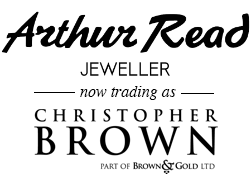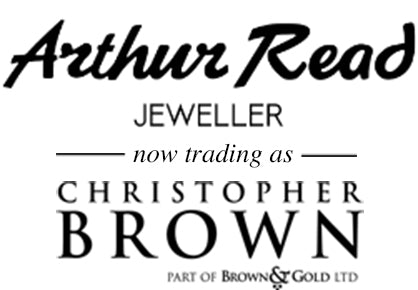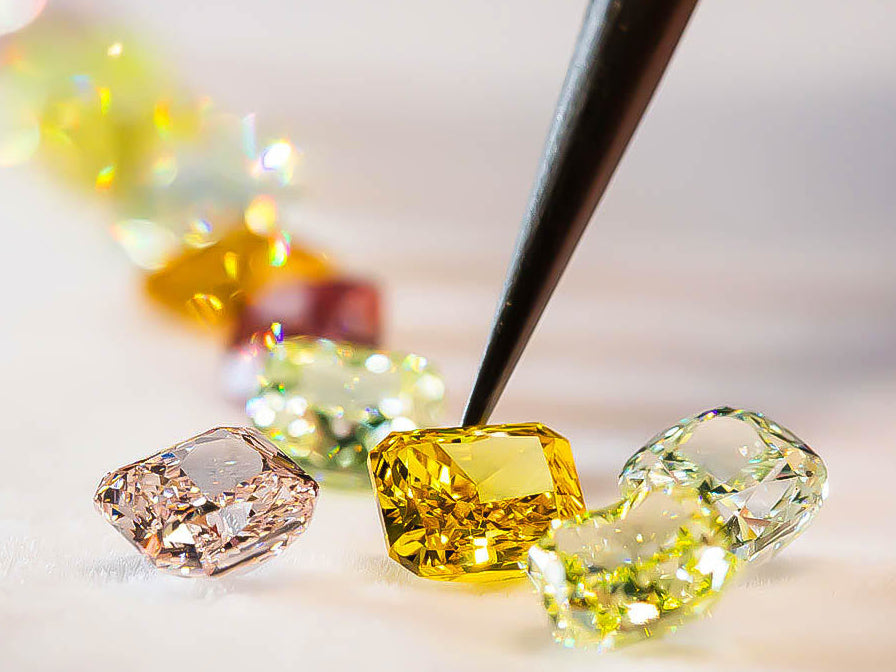Guide to Coloured Diamonds
- 04 Oct 2019
- Daniel Read
Colour in diamonds is seen as both undesirable, and desirable. Undesirable because at low levels, the diamond can take on a pale colour, such as yellow or brown, which leads to it being added lower down the international scale of D to Z, and desirable because at high levels they look awesome. Most people start to see colour in a diamond at about H or I grades, and these are deemed less desirable than, say, a D grade, and so are priced lower. This perceived reduction in value continues until you reach a certain saturation of colour, after which the diamond becomes termed fancy colour, and the price then increases, and for some colours and concentrations, this can be way above the levels achieved by truly colourless diamonds. Diamonds come in every colour and shade of the rainbow as confirmed by the Natural History Museum in London. It has the Aurora Diamonds on display, 296 naturally coloured stones, with a total weight of 267.45ct.

The causes of colour in diamonds are many and varied, and in some cases are still relatively unknown. The following is a brief, if slightly scientific, rundown of some of these causes, and the colours created. The most common colours seen are yellows and browns. Yellow is due to atoms of nitrogen being scattered throughout the diamond. As the number of these increases, so does the depth of colour. Browns, on the other hand, aren't caused by impurities but instead the diamond has been squashed and squeezed as it grew deep in the ground. These different directions of pressure caused the structure to become distorted, and as the conditions were not suitable for the diamond to relieve these stresses, 'plastic deformation' occurred This is an important cause of colour, because not only is it responsible for brown, but it also causes pinks and even reds in diamond, depending upon the amount of directional pressure applied.
Reds are amongst the rarest of all colours in diamond, and very few pure red diamonds have been found- one known as the DeYoung Red was allegedly sold through an estate sale as a garnet. Because of the colour, it was assumed not to be a diamond!

The Hope Diamond (45.52ct), is possibly the most famous coloured diamond that exists. The blue colour is due to very small concentrations of boron (a very light element), and this also gives blue diamonds a unique property-the ability to conduct electricity. All other diamonds are insulators. Very small levels of boron can create a significant blue coloration, far smaller concentrations than would be required to create a similar concentration of yellow. Natural blue diamonds are rare, and can achieve very high prices at auction (for example, when Sotheby's auctioned 'The Blue', a 9.75ct pear cut diamond in 2014, it reached $326 million), but not as high as reds do- in 2014, a 2.09ct heart- shaped red diamond sold for $5 million- that's $2.5 million per carat!
Another colour seen in diamond, although not usually in a deep shade, is green. This is caused by exposure to radioactive elements or particles that, over thousands of years, have damaged the structure, forcing atoms out of their correct positions. These misplaced atoms absorb light, and create a green colour, but only in the surface layers. Polish this surface away too much, and the green colour disappears. Arguably the most famous green diamond is the Dresden Green (41ct). This is unique, even among green diamonds, as the colour penetrates the whole stone- most radiation sources aren't powerful enough to colour a whole stone. Interestingly, if this were sent to a modern lab, it would probably come back with a report stating that it had been treated, so rare was the natural event that caused it, but so easy to recreate in a lab environment. I should point out that, although radiation is the cause of this colour, the stones themselves aren't radioactive!

Black diamonds have become popular in recent years. They can be either natural or treated in nature, and can be due to several factors. The diamond may contain so many dark inclusions that the overall appearance is black. It could have been irradiated, which would normally be done in a lab, to help what was potentially a dark coloured diamond achieve its full potential to be opaque and dark Probably the least common cause, is for the diamond to contain extremely high levels of nitrogen. In smaller doses, this is the same element that causes yellow, but if it gets to sufficiently high levels, a black colour is created.
And finally, a colour that is seen in some diamonds, such as the Pumpkin, but about which not much is known is orange. At the time of writing this article, the definitive cause of colour in orange diamonds is still under discussion. So few have been tested that the factors affecting the colour have not yet been determined. Despite this, one weighing 14.82ct was sold at a Geneva auction in 2013 for an amazing 5.5 million.
Finally, there are diamonds that can change colour. Known as chameleon diamonds, these begin as olive green and can turn to brown or brown-yellow when heated, or left in the dark, reverting to their original shade when returned to normal temperature/ light. Some even work in reverse, starting brown, then becoming a greenish brown colour. The jury is still out on how that happens
Taken from The Guild of Jeweller's Coloured Stones Guide Vol.1



Comments
qZtyUPYdbHVOzjL
IBlVRtpE
AKoxgVLyS
peMOlEzNcoGqRQd
FfUETnHzyeJM